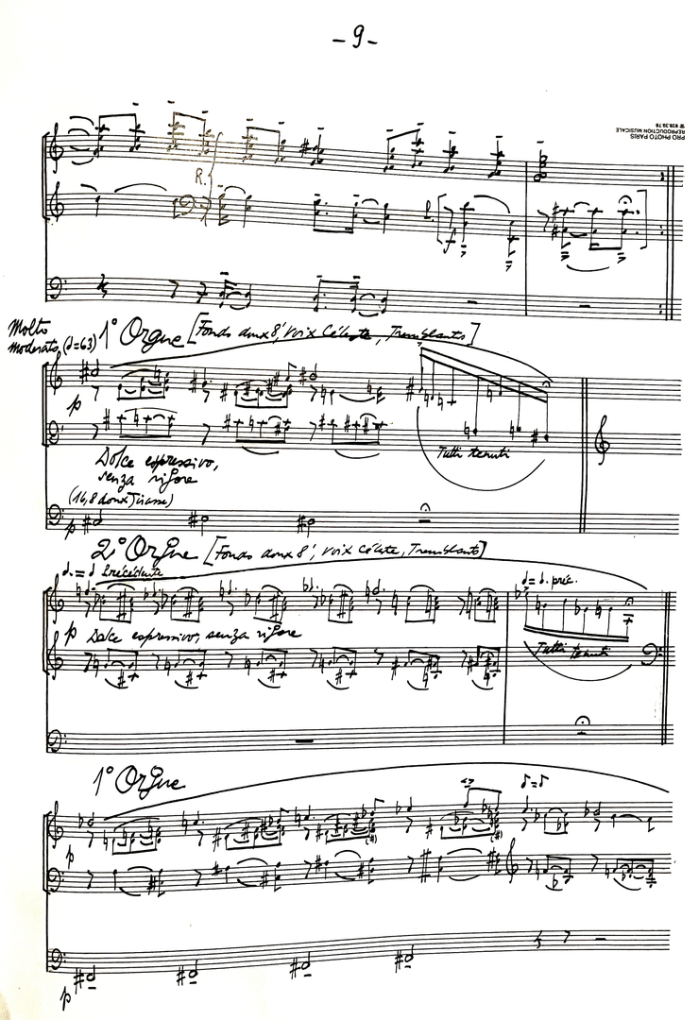Title, Duration, Place, Year, Publisher, Dedicated to, Premiere (performer(s), place,
date)
FANTAISIE SUR "ADESTE FIDELES", (for two organs ad libitum), 8', Paris,
1986, Bornemann/Leduc, à ma femme Marie-Bernadette Dufourcet, Naji Hakim and M.B. Dufourcet Basilique du Sacré-Cœur, Paris, 01.87
La puissance d'évocation de certains chants liturgiques populaires reste très forte. "Adeste fidèles" est de ceux-là. Quand il retentit à la
fin de la messe de minuit dans la Basilique de Montmartre, personne ne doute que c'est bien Noël qui vient d'être célébré. On comprend que l'organiste de la Basilique, pour son deuxième Noël au
Sacré-Coeur, ait voulu en donner une version originale exploitant les richesses de ce thème et utilisant la ressource étonnante que constituent les deux orgues de la Basilique. Le chant n'est-il pas
un dialogue de Dieu et de son peuple fidèle reproduisant le dialogue des anges et des bergers? Ajoutez-y un carillon majestueux pour l'introduction et repris finement dans la coda, et vous aurez
cette belle pièce dont les cinq variations contrastées (Décidé, Pastoral, Volubile, Paisible, Eclatant) soulignent que la paix de Noël s'inscrit dans le brouhaha du monde indifférent et que
l'abaissement du Verbe, défi à notre intelligence, n'est apprécié que par les humbles de coeur.Permettez au signataire de ces lignes de rajouter un souvenir personnel. Si pour lui ce
chant accompagne tout le temps de Noël dans les célébrations de la basilique, il évoque aussi ce Noël célébré en plein mois d'août à Bethléem. Ce sen sont pluches anges, mais des centaines de
pèlerins en aube blanche qui viennent à la vraie crèche adorer le vrai Dieu fait homme.
Père François de Vorges,
Recteur de la Basilique du
Sacré-Coeur
Montmartre, Paris
Certain popular liturgical melodies retain
considerable evocation of power. "Adeste fiddles" is one such melody. When it breaks forth at the close of midnight mass at the Basilica of Montmartre, there is no doubt that it is Christmes which
has just been celebrated. One perceives that the Basilica's organist, for his second Christmas at Sacré-Coeur, had wished to create an original version, exploiting the rich potential of this theme
and utilizing the stunning resource of the Basilica's two organs. Isn't this hymn a dialogue between God and his faithful people, recalling the dialogue of the angels and the shepherds? Add to this
the majestic carillon of the introduction, taken up again at the coda, and you will have this fine piece consisting of five contrasting variations (Resolute, Pastorale, Lively, Peaceful, Brilliant),
emphasizing that the descent of the Word, in defiance to our intelligence, is only appreciated by those who are humble at heart.
Allow the writer of these lines to add a
personal recollection. While for him this hymn is associated with all the Basilica's Christmastide celebrations, it also evokes the famous mid-August Christmas celebration in Bethlehem, where instead
of angels, hundreds of white-robed pilgrims come to the actual site of the cradle to adore the true God made man.
Father François de Vorges
Rector, Basilica of the Sacred
Heart,
Montmartre, Paris
This work was written in December, 1986, for a recital given by Hakim and his wife, Marie-Bernadette
Dufourcet, at the Sacré-Cœur. It is conceived as a duo, using the Grand Organ and Choir Organ in the Basilica. This antiphonal use of the organs is interpreted by the former Rector of
the Sacré-Cœur, Father François de Vorges, as a ''dialogue between God and his faithful people, recalling the dialogue of the angels and shepherds''.
The theme and variations form of the Fantaisie lends itself very successfully to this
well-known Christmas hymn. Following the exuberant opening chords of the introduction, the hymn, slightly syncopated, is presented in a chordal harmonization with open fifths, using the mixtures, in
alternation with triadic passages on the reeds. The introduction is then re-stated, and this marks the beginning of the four contrasted variations. The first of these assigns the melody, in
inversion, to the pedal with a rhythmic accompaniment. Arpeggiated arabesques outlining the melody, played on Flutes of 8, 4 and 2 foot pitch, highlight the next section, which leads into the lush
third variation. The strings and soft foundation stops of the two organs again dialogue, the melody clearly soaring above accompanying cascading clusters. After a crescendo which bridges the gap
between the variations, a brief quotation from The Embrace of Fire prepares the final toccata. The Choir Organ takes the first turn, with the melody alternating between manual and
pedal, and the Grand Organ continues with the reprise. A final appearance of the introductory theme leads to the coda, march-like in character, in which the dialogue continues up to the last chord,
where the organs sound together, triumphant.
Amy Johansen


